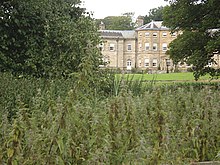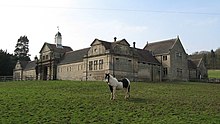Chesters is an 18th-century country mansion adjacent to Hadrian's Wall and the Roman fort of Cilurnum at Humshaugh, Northumberland, England. It is a Grade II* listed building.[1]


The house was built for John Errington of Walwick Grange[2] in about 1771 with three storeys and four bays but was much improved and extended by architect Norman Shaw in 1891. The 1891 work included five two-storeyed three-bay wings and a stable block. The stable block is separately Grade II* listed.[3]
Of the five wings, three were diagonal, creating suntrap flanks for the south and west fronts.[1] Shaw's remodelling of Chesters kindled the popularity of the butterfly plan in the late 19th and early 20th centuries.[4]
The estate was acquired by Nathaniel Clayton[2] (Town Clerk of Newcastle upon Tyne 1785–1822) in 1796. His son John Clayton, who succeeded him as Town Clerk in 1822, was a keen antiquarian and excavated the ruins of the Roman fort of Cilurnam adjacent to the house. He made a large collection of Roman artefacts, which is now displayed at Chesters Museum.